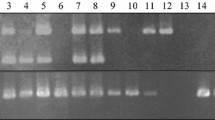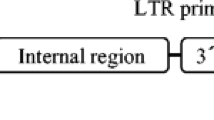Abstract
Long terminal repeat retrotransposons (LTR-RTs) contribute a large fraction of many sequenced plant genomes and play important roles in genomic diversity and phenotypic variations. LTR-RTs are abundantly distributed in plant genomes, facilitating the development of markers based on LTR-RTs for a variety of genotyping purposes. Whole-genome analysis of LTR-RTs was performed in Cleistogenes songorica. A total of 299,079 LTR-RTs were identified and classified as Gypsy type, Copia type, or other type. LTR-RTs were widely distributed in the genome, enriched in the heterochromatic region of the chromosome, and negatively correlated with gene distribution. However, approximately one-fifth of genes were still interrupted by LTR-RTs, and these genes are annotated. Furthermore, four types of primer pairs (PPs) were designed, namely, retrotransposon-based insertion polymorphisms, inter-retrotransposon amplified polymorphisms, insertion site–based polymorphisms, and retrotransposon-microsatellite amplified polymorphisms. A total of 350 PPs were screened in 23 accessions of the genus Cleistogenes, of which 80 PPs showed polymorphism, and 72 PPs showed transferability among Gramineae and non-Gramineae species. In addition, a comparative analysis of homologous LTR-RTs was performed with other related grasses. Taken together, the study will serve as a valuable resource for genotyping applications for C. songorica and related grasses.






Similar content being viewed by others
Data availability
The datasets generated and analyzed during the current study project has been deposited at DDBJ/ENA/GenBank under the accession KDOP00000000. The version described in this paper is the first version, KDOP01000000.
References
Ali F, Abdurrahim Y, Muhammad AN, Ephrem H, Ilhan S, Muhammad AN et al (2019) Mobile genomic element diversity in world collection of safflower (Carthamus tinctorius L.) panel using iPBS-retrotransposon markers. PLoS One 14:e0211985. https://doi.org/10.1371/journal.pone.0211985
Anderson JA, Churchill GA, Autrique JE, Tanksley SD, Sorrells ME (1993) Optimizing parental selection for genetic linkage maps. Genome 36:181–186. https://doi.org/10.1139/g93-024
Arabidopsis Genome I (2000) Analysis of the genome sequence of the flowering plant Arabidopsis thaliana. Nature 408:796–815. https://doi.org/10.1038/35048692
Bennetzen JL (2000) Transposable element contributions to plant gene and genome evolution. Plant Mol Biol 42:251–269
Bennetzen JL (2005) Transposable elements, gene creation and genome rearrangement in flowering plants. Curr Opin Genet Dev 15:621–627. https://doi.org/10.1016/j.gde.2005.09.010
Beule T, Agbessi MD, Dussert S, Jaligot E, Guyot R (2015)Genome-wide analysis of LTR-retrotransposons in oil palm. BMC Genomics 16:795. https://doi.org/10.1186/s12864-015-2023-1
Brandes A, Heslop-harrison JS, Kamm A, Kubis S, Doudrick R, Schmidt T (1997) Comparative analysis of the chromosomal and genomic organization of Ty1-copia-like retrotransposons in pteridophytes, gymnosperms and angiosperms. Plant Mol Biol 33:11–21
Bucher E, Reinders J, Mirouze M (2012) Epigenetic control of transposon transcription and mobility in Arabidopsis. Curr Opin Plant Biol 15:503–510. https://doi.org/10.1016/j.pbi.2012.08.006
Casacuberta E, Gonzalez J (2013) The impact of transposable elements in environmental adaptation. Mol Ecol 22:1503–1517. https://doi.org/10.1111/mec.12170
Conesa A, Gotz S, Garcia-Gomez JM, Terol J, Talon M, Robles M (2005) Blast2GO: a universal tool for annotation, visualization and analysis in functional genomics research. Bioinformatics 21(18):3674–3676. https://doi.org/10.1093/bioinformatics/bti610
Dellaporta SL, Wood J, Hicks JB (1983) A plant DNA minipreparation: version II. Plant Mol Biol Report 1(4):19–21
Feschotte C (2008) Transposable elements and the evolution of regulatory networks. Nat Rev Genet 9:397–405. https://doi.org/10.1038/nrg2337
Feschotte C, Keswani U, Ranganathan N, Guibotsy ML, Levine D (2009) Exploring repetitive DNA landscapes using REPCLASS, a tool that automates the classification of transposable elements in eukaryotic genomes. Genome Biol Evol 1:205–220. https://doi.org/10.1093/gbe/evp023
Goodstein DM, Shu SQ, Howson R, Neupane R, Hayes RD, Fazo J et al (2012) Phytozome: a comparative platform for green plant genomics. Nucleic Acids Res 40:D1178–D1186. https://doi.org/10.1093/nar/gkr944
Gregory TR (2005) Synergy between sequence and size in large-scale genomics. Nat Rev Genet 6:699–708. https://doi.org/10.1038/nrg1674
Gross BL, Olsen KM (2010) Genetic perspectives on crop domestication. Trends Plant Sci 15(9):529–537. https://doi.org/10.1016/j.tplants.2010.05.008
He N, Zhang C, Qi XW, Zhao S, Tao Y, Yang GJ et al (2013) Draft genome sequence of the mulberry tree Morus notabilis. Nat Commun 4:2445. https://doi.org/10.1038/ncomms3445
Heslop-harrison JS, Brandes A, Taketa S, Schmidt T, Vershinin AV, Alkhimova EG et al (1997) The chromosomal distributions of Ty1-copia group retrotransposable elements in higher plants and their implications for genome evolution. Genetica 100:197–204
Kalendar R, Schulman AH (2006) IRAP and REMAP for retrotransposon-based genotyping and fingerprinting. Nat Protoc 1:2478–2484
Kalendar R, Flavell AJ, Ellis TH, Sjakste T, Moisy C, Schulman AH (2011) Analysis of plant diversity with retrotransposon-based molecular markers. Heredity (Edinb) 106:520–530. https://doi.org/10.1038/hdy.2010.93
Kashkush K, Feldman M, Levy AA (2003) Transcriptional activation of retrotransposons alters the expression of adjacent genes in wheat. Nat Genet 33:102–106. https://doi.org/10.1038/ng1063
Kidwell MG (2002) Transposable elements and the evolution of genome size in eukaryotes. Genetica 115:49–63
Krzywinski M, Schein J, Birol I, Connors J, Gascoyne R, Horsman D et al (2009) Circos: an information aesthetic for comparative genomics Genome. Res 19:1639–1645. https://doi.org/10.1101/gr.092759.109
Kumar A, Bennetzen JL (1999) Plant retrotransposons. Annu Rev Genet 33:479–532. https://doi.org/10.1146/annurev.genet.33.1.479
Kunze R, Saedler H, Lönnig WE (1997) Plant transposable elements. Adv Bot Res Elsevier:331–470. https://doi.org/10.1016/s0065-2296(08)60284-0
Li X, Guo K, Zhu X, Chen P, Li Y, Xie G et al (2017) Domestication of rice has reduced the occurrence of transposable elements within gene coding regions. BMC Genomics 18:55. https://doi.org/10.1186/s12864-016-3454-z
Liang Y, Lenz RR, Dai W (2016) Development of retrotransposon-based molecular markers and their application in genetic mapping in chokecherry (Prunus virginiana L.). Mol Breed 36:109. https://doi.org/10.1007/s11032-016-0535-2
Liu Z, Liu YL, Liu F, Zhang SL, Wang XX, Lu QW et al. (2018)Genome-wide survey and comparative analysis of long terminal repeat (ltr) retrotransposon families in four gossypium species. Sci Rep 8:9399. https://doi.org/10.1038/s41598-018-27589-6
McClintock B (1951) Chromosome organization and genic expression. Cold Spring Harb Symp Quant Biol 16:13–47. https://doi.org/10.1101/sqb.1951.016.01.004
Nan ZB, Wang SM, Wang YR, Fu H, Li CJ, Duan TY (2016) Stress tolerance mechanisms of 6 native plant species growing in China’s northern grassland and their utilization. Chin Sci Bull 61:239–249
Oksanen J, Blanchet FG, Kindt R, Legendre P, O’hara RB, Simpson GL et al (2010) Vegan: community ecology package. R package version 1.17-4. http://cran.r-project.org
Oliver KR, McComb JA, Greene WK (2013) Transposable elements: powerful contributors to angiosperm evolution and diversity. Genome Biol Evol 5:1886–1901. https://doi.org/10.1093/gbe/evt141
Ou S, Ning J (2019) LTR_FINDER_parallel: parallelization of LTR_FINDER enabling rapid identification of long terminal repeat retrotransposons. Mob DNA 10(1):48. https://doi.org/10.1101/722736
Ragupathy R, You FM, Cloutier S (2013) Arguments for standardizing transposable element annotation in plant genomes. Trends Plant Sci 18:367–376. https://doi.org/10.1016/j.tplants.2013.03.005
Rohlf FJ (1992) NTSYS-pc: numerical taxonomy and multivariate analysis system Version 2.2. Stony Brook, New York
Sakai H, Lee SS, Tanaka T, Numa H, Kim J, Kawahara Y et al (2013) Rice Annotation Project Database (RAP-DB): an integrative and interactive database for rice genomics. Plant Cell Physiol 54:e6. https://doi.org/10.1093/pcp/pcs183
Schulman AH, Flavell AJ, Paux E, Ellis TH (2012) The application of LTR retrotransposons as molecular markers in plants. Methods Mol Biol 859:115–153. https://doi.org/10.1007/978-1-61779-603-6_7
Tempel S (2012) Using and understanding RepeatMasker. Methods Mol Biol 859:29–51. https://doi.org/10.1007/978-1-61779-603-6_2
Verma S, Rana TS (2011) Genetic diversity within and among the wild populations of Murraya koenigii (L.) Spreng., as revealed by ISSR analysis. Biochem Syst Ecol 39:139–144. https://doi.org/10.1016/j.bse.2011.01.017
Wang Y, Thomas D, Vijay TK, Dong LL, Ajay (2015) Development of a D genome specific marker resource for diploid and hexaploid wheat. BMC Genomics 16:646. https://doi.org/10.1186/s12864-015-1852-2
Wanjugi H, Coleman-Derr D, Huo H, Kianian SF, Luo MC, Wu J et al (2009) Rapid development of PCR-based genome-specific repetitive DNA junction markers in wheat. Genome 52:576–587. https://doi.org/10.1139/g09-033
Waugh R, McLean K, Flavell AJ, Pearce SR, Kumar A, Thomas BB, Powell W (1997) Genetic distribution of Bare-1-like retrotransposable elements in the barley genome revealed by sequence-specific amplification polymorphisms (S-SAP). Mol Gen Genet 253:687–694. https://doi.org/10.1007/s004380050372
Wicker T, Sabot F, Hua-Van A, Bennetzen JL, Capy P, Chalhoub B et al (2007) A unified classification system for eukaryotic transposable elements. Nat Rev Genet 10(12):276
Wicker T, Gundlach H, Spannagl M, Uauy C, Borrill P, Ramirez-Gonzalez RH et al (2018) Impact of transposable elements on genome structure and evolution in bread wheat. Genome Biol 19(1):103. https://doi.org/10.1186/s13059-018-1479-0
Woffelman C (2004) DNAMAN for Windows, Version 5.2. 10. Lynon Biosoft, Institute of Molecular Plant Sciences, Netherlands: Leiden University
Yadav CB, Bonthala VS, Muthamilarasan M, Pandey G, Khan Y, Prasad M (2015)Genome-wide development of transposable elements-based markers in foxtail millet and construction of an integrated database. DNA Res 22:79–90. https://doi.org/10.1093/dnares/dsu039
You FM, Humphrey W, Naxin H, Lazo GR, Ming CL, Anderson OD et al (2010) RJPrimers: unique transposable element insertion junction discovery and PCR primer design for marker development. Nucleic Acids Res 38:W313–W320. https://doi.org/10.1093/nar/gkq425
Zhang J, John UP, Wang Y, Li X, Nan ZB (2011) Targeted mining of drought stress-responsive genes from EST resources in Cleistogenes songorica. J Plant Physiol 168:1844–1851. https://doi.org/10.1016/j.jplph.2011.04.005
Zhang Z, Min X, Wang Z, Wang Y, Liu Z, Liu W (2017)Genome-wide development and utilization of novel intron-length polymorphic (ILP) markers in Medicago sativa. Molecular Breeding 37:87. https://doi.org/10.1007/s11032-017-0659-z
Zhang J, Wu F, Yan Q, John UP, Cao MS, Xu P et al (2020) The genome of Cleistogenes songorica provides a blueprint for functional dissection of dimorphic flower differentiation and drought adaptability. Plant Biotechnol J 19(3):532–547. https://doi.org/10.1111/pbi.13483
Funding
This research was supported by the program for grants from the National Natural Science Foundation of China (31572453, 31601984), The Gansu Provincial Science and Technology Major Projects (19ZD2NA002), The Gansu Provincial Intellectual Property Program (19ZSCQ044), and the Open Project Program of Arid Meteorology (IAM201703).
Author information
Authors and Affiliations
Contributions
Tiantian Ma and Jiyu Zhang conceived the study and designed the experiments; Xingyi Wei, Yufei Zhang, Jie Li, and Tiantian Ma performed the experiments; Tiantian Ma, Fan Wu, Qi Yan, Zhuanzhuan Yan, Yingbo Yang, and Zhengshe Zhang analyzed the data and interpreted the results; Tiantian Ma and Jiyu Zhang drafted the manuscript with contributions from Gisele Kanzana and Yufeng Zhao; all authors read and approved the final manuscript.
Corresponding author
Ethics declarations
Conflict of interest
The authors declare no competing interests.
Informed consent
Informed consent was obtained from all individual participants included in the study.
Additional information
Communicated by: Izabela Pawłowicz
Publisher’s note
Springer Nature remains neutral with regard to jurisdictional claims in published maps and institutional affiliations.
Supplementary Information
Table S1
Details of LTR retrotransposons identified in Cleistogenes songorica. (XLSX 13799 kb)
Table S2
Details of LTR retrotransposons identified in Cleistogenes songorica that can be successfully mapped to chromosomes. (XLSX 12667 kb)
Table S3
Details of the distribution of each type of LTR retrotransposons on 20 chromosomes of Cleistogenes songorica. (XLSX 14 kb)
Table S4
Details of the Cleistogenes songorica LTR retrotransposon-based markers developed in the study. (XLSX 36 kb)
Table S5
List of 80 LTR retrotransposon-based molecular marker primers with their sequence used to determine genetic diversity among 23 accessions of the genus Cleistogenes. (XLSX 16 kb)
Table S6
Nei’s genetic distance computed to evaluate genetic diversity among 23 accessions of the genus Cleistogenes using 80 LTR retrotransposon-based molecular marker primers. (XLSX 13 kb)
Fig. S1
Analysis of KEGG (Kyoto Encyclopedia of Genes and Genomes) enrichment pathway for Cleistogenes songorica genes which were interrupted with LTR-RTs. (PNG 8 kb)
Fig. S2
Distribution of LTR retrotransposon-based markers on the chromosomes of Cleistogenes songorica. (PNG 147336 kb)
Rights and permissions
About this article
Cite this article
Ma, T., Wei, X., Zhang, Y. et al. Development of molecular markers based on LTR retrotransposon in the Cleistogenes songorica genome. J Appl Genetics 63, 61–72 (2022). https://doi.org/10.1007/s13353-021-00658-9
Received:
Revised:
Accepted:
Published:
Issue Date:
DOI: https://doi.org/10.1007/s13353-021-00658-9




